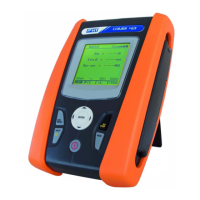
Do you have a question about the HT 400 Series and is the answer not in the manual?
| Type | Digital Multimeter |
|---|---|
| Diode Test | Yes |
| Auto Ranging | Yes |
| Data Hold | Yes |
| Operating Temperature | 0°C to 40°C |
| DC Current Range | 400μA to 10A |
| AC Current Range | 400μA to 10A |
| Resistance Range | 400Ω to 40MΩ |
| Continuity Test | Yes |
| Display | LCD, 4000 counts |
| Measurement Range | As per individual functions |
Instructions for safe and correct initial setup and usage of the instrument.
Recommendations for safe operation of the instrument during measurements.
Procedures for safely turning off and storing the instrument after use.
Definitions and explanations of measurement categories for electrical safety.
Overview of the instrument models and their measuring functions.
Details on the tests and functions the instrument can perform.
Steps to verify the instrument's condition and package contents before first use.
Information on battery type, replacement, and power management features.
Details on instrument calibration and warranty period.
Guidelines for proper storage to ensure measurement accuracy.
Identification and description of the instrument's front panel and connectors.
Explanation of the functions of each key on the instrument's keyboard.
Accessing measurement functions like AUTO and POWER via the main menu.
Configuration options for language, auto power off, voltage, frequency, and system.
Accessing and managing saved measurements and memory locations.
Performing an automatic sequence of tests for electrical safety.
Interpreting and handling abnormal readings during AUTO function tests.
Performing continuity tests of earth and equipotential conductors with 200mA.
Procedure for calibrating test leads to compensate for cable resistance.
Interpreting and handling abnormal continuity test results.
Measuring insulation resistance between active conductors and earth.
Interpreting and handling abnormal insulation resistance test results.
Testing tripping time and current of RCDs for A and AC types.
Performing an automatic sequence of RCD tests with nominal current.
Measuring RCD tripping time with half nominal current.
Measuring RCD tripping time at 1x, 2x, and 5x nominal current.
Detecting tripping time at tripping current (lower than nominal).
Measuring contact voltage and total earth resistance without tripping RCD.
Interpreting and handling abnormal RCD test results.
Measuring line and fault loop impedance and calculating prospective fault current.
Measuring impedance between phase and neutral conductors.
Measuring impedance between two phase conductors.
Measuring fault loop impedance in TT or TN systems.
Measuring fault loop impedance in IT systems.
Interpreting and handling abnormal loop impedance test results.
Measuring total earth resistance through the socket-outlet.
Interpreting and handling abnormal earth resistance test results.
Testing the phase sequence by direct contact with live parts.
Interpreting and handling incorrect phase sequence detection.
Measuring environmental parameters using external transducers.
Using specific modes for measuring air, humidity, temperature, and light.
Interpreting and handling anomalous environmental measurement results.
Measuring leakage current in real time using an external clamp.
Interpreting and handling anomalous leakage current readings.
Measuring mains voltage, current, and harmonic parameters.
Measuring electrical parameters like voltage, current, power, and power factor.
Procedure for saving measured data, including parameter settings.
Navigating and managing stored measurements using REC, PAG, and CANC functions.
Procedure for connecting the instrument to a PC for data transfer.
Procedure for replacing the instrument's batteries safely.
Instructions for cleaning the instrument using a dry, soft cloth.
Detailed technical specifications and accuracy for various measurement functions.
List of relevant safety and measurement standards applied to the instrument.
Mechanical data, power supply, display, and memory specifications.
Environmental conditions for operation and storage.
List of accessories provided with the instrument.
Terms and conditions of the instrument's warranty and exclusions.
Troubleshooting steps and return procedures for service.
Testing continuity of protective and equipotential conductors.
Checking installation insulation resistance against standards.
Verifying insulation resistance for SELV, PELV, and electrical separation.
Checking the proper installation and adjustment of general and selective RCDs.
Checking the real tripping current of general RCDs.
Checking tripping power against maximum fault current.
Measuring fault loop impedance and detecting prospective fault current.
Checking RCD coordination with earth resistance value.
Theory and analysis of voltage and current harmonics in electrical systems.
Definitions and formulas for active, reactive, and apparent power and power factor.